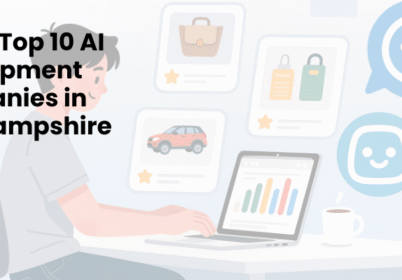Replit AI vs Lovable AI: A Complete Handbook for Choosing the Right Platform
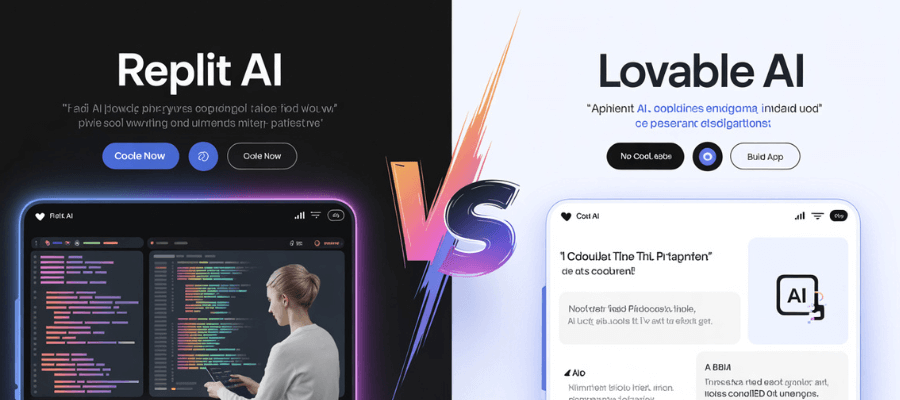
Table of Contents
The software development landscape has transformed dramatically with AI-powered coding platforms leading the charge. Replit AI vs Lovable AI represents two innovative approaches making software creation more accessible and efficient than ever before. These platforms are revolutionizing how developers, startups, and non-technical users build applications, with adoption rates increasing by over 200% in the past year alone. Replit AI vs Lovable AI exemplifies the growing divide between developer-focused coding environments and no-code AI solutions reshaping the industry.
Replit has established itself as a collaborative cloud-based IDE with over 20 million users worldwide. Meanwhile, Lovable AI has emerged as a powerful no-code solution enabling founders to transform ideas into functional applications through simple text prompts. Both platforms leverage artificial intelligence to streamline development, yet they serve distinctly different user bases and project requirements.
Whether you are a seasoned developer, startup founder, or business professional exploring AI development options, understanding the nuances between Replit AI vs Lovable AI will help you select the right tool for your specific needs.
主要ポイント
- Readers will understand how Replit AI and Lovable AI represent two very different approaches to modern software development.
- Compare how Replit empowers developers with deep customization while Lovable enables non-technical users to build apps with text prompts.
- Identify which platform fits specific needs—Replit for complex, production-ready projects or Lovable for rapid MVPs and simple tools.
- Discover how AI functions differently—Replit’s Ghostwriter acts as an assistant, while Lovable’s AI generates entire applications.
- Evaluate deployment, collaboration, and database capabilities to see how each platform handles project scaling and integrations.
- Choose the right platform by weighing technical expertise, project complexity, budget, and growth goals—some teams benefit from using both.
Table of Contents
What is Replit AI?
Replit is a browser-based integrated development environment founded in 2016 by Amjad Masad, Haya Odeh, and Faris Masad. The platform combines code editing, file management, hosting, and collaboration features into a unified cloud-based ecosystem. Replit has evolved from a simple code playground into a comprehensive development platform supporting over 50 programming languages and frameworks.
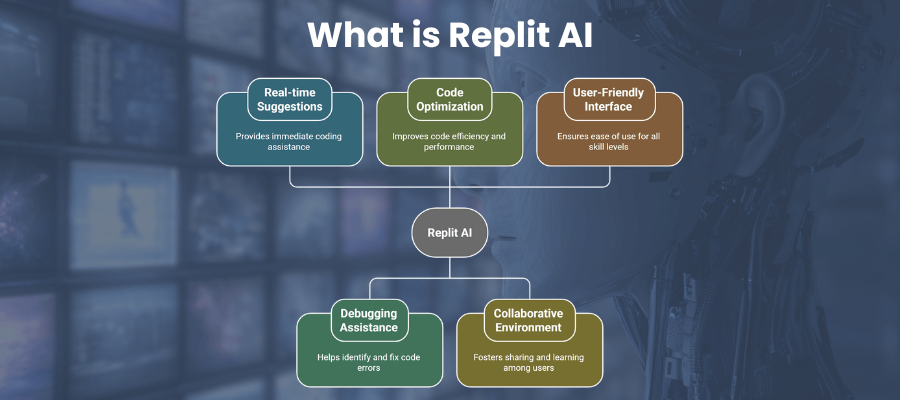
At its core, Replit aims to make coding more accessible by removing environment setup barriers. Users can begin programming immediately without installing software or configuring development environments. This approach has made Replit particularly popular among students, educators, and developers seeking collaborative coding solutions.
The platform introduced Replit Ghostwriter in 2022, an AI coding assistant powered by advanced language models. This feature enhances the development experience through code completion, generation, and explanation capabilities. With over 20 million users globally, Replit has established itself as a leading collaborative development environment for projects ranging from educational exercises to production applications.
Key Features of Replit AI
Replit distinguishes itself through several standout features that appeal to developers across experience levels:
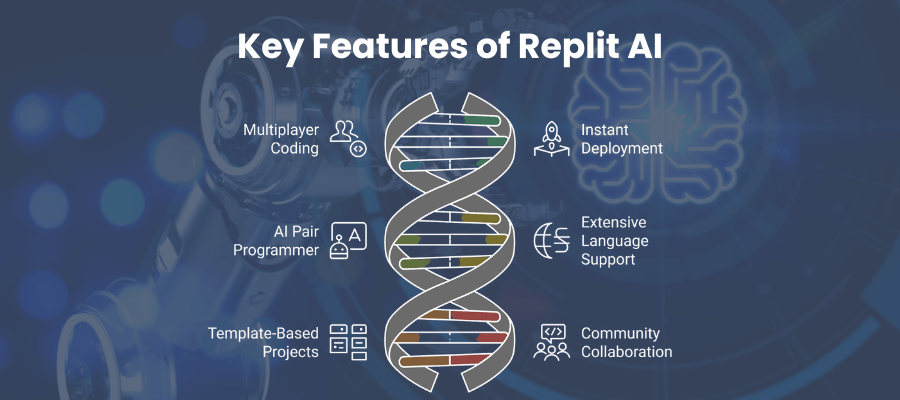
Multiplayer Coding Environment: Replit enables real-time collaboration similar to Google Docs. Multiple developers can simultaneously edit code, view changes, and communicate within the same workspace. This feature makes pair programming and team collaboration seamless regardless of geographic location.
Instant Deployment and Hosting: Projects created in Replit can be deployed instantly with unique URLs. The platform handles infrastructure management, allowing developers to focus on code rather than deployment configurations. This includes automatic HTTPS, custom domains, and continuous deployment from Git repositories.
Replit Ghostwriter (AI Pair Programmer): This AI assistant helps developers write code faster through:
- Intelligent code completion suggestions
- Automatic bug detection and fixing
- Natural language to code translation
- Code explanation and documentation generation
Extensive Language Support: Replit supports over 50 programming languages including Python, JavaScript, Ruby, C++, Java, and specialized frameworks like React and Node.js. Each language environment comes preconfigured with necessary compilers and interpreters.
Template-Based Projects: Users can jumpstart development with hundreds of project templates ranging from web applications to machine learning models. These templates provide working codebases that can be customized for specific needs.
Community Collaboration: Replit’s community features allow developers to share projects, fork existing applications, and collaborate on open-source initiatives. The platform includes social elements where users can discover interesting projects and connect with other developers.
What is Lovable AI?
Lovable AI represents a new generation of AI-powered development platforms focused on making application creation accessible to non-developers. Founded in 2022, Lovable positions itself as a no-code/low-code solution that transforms natural language descriptions into functional web applications. The platform has gained significant traction among startup founders, product managers, and entrepreneurs seeking rapid prototyping capabilities.
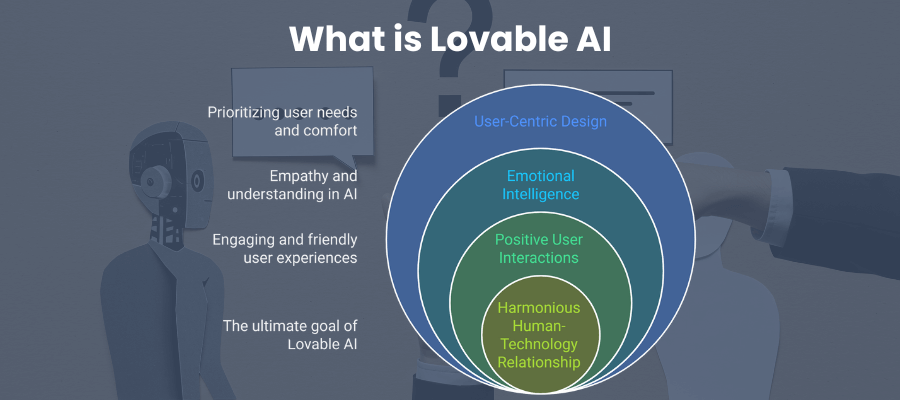
Unlike traditional development environments, Lovable AI emphasizes natural language interaction over manual coding. Users describe their desired application in plain English, and the platform generates the corresponding code and visual interfaces automatically. This approach significantly reduces the technical knowledge required to create software applications.
Lovable AI has built its reputation on the concept of “vibe coding” – the ability to communicate application requirements conversationally rather than through formal programming syntax. The platform handles both frontend and backend implementation details, allowing users to focus on product vision rather than technical implementation.
With venture capital backing exceeding $15 million, Lovable has quickly established itself as a prominent player in the AI-assisted development space. The platform currently serves over 50,000 users ranging from solo entrepreneurs to established startups seeking faster development cycles.
Key Features of Lovable AI
Lovable AI offers several distinctive capabilities that make it particularly valuable for rapid application development:
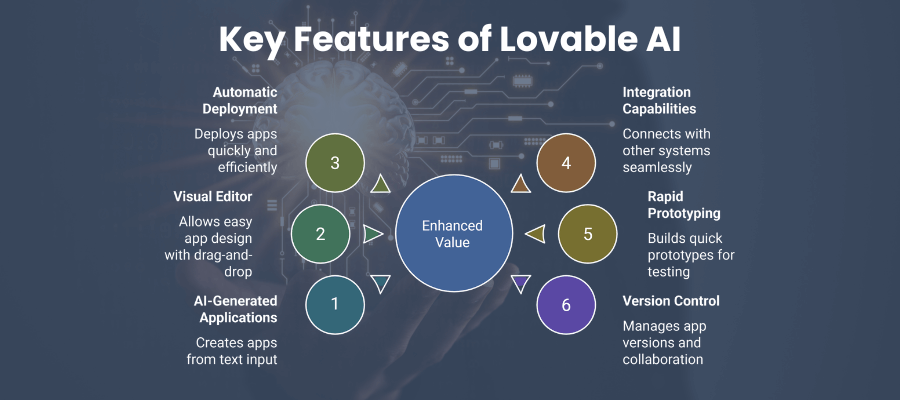
AI-Generated Applications from Text: The platform’s core functionality allows users to describe applications in natural language. Lovable’s AI engine interprets these descriptions and generates corresponding code, database structures, and user interfaces automatically. Users can refine applications through iterative prompting.
Visual Drag-and-Drop Editor: After AI generation, Lovable provides a visual editor for refining application interfaces. This editor requires minimal technical knowledge while offering customization options for layouts, colors, and component behaviors. Changes made visually are automatically translated into code.
Automatic Deployment: Applications built with Lovable can be deployed instantly with shareable URLs. The platform handles hosting infrastructure, database provisioning, and security configurations. Users can also connect custom domains for production deployments.
Integration Capabilities: Lovable supports integration with popular third-party services including:
- Payment processors (Stripe, PayPal)
- Authentication providers (Auth0, Firebase)
- Database services (MongoDB, PostgreSQL)
- Email marketing tools (Mailchimp, SendGrid)
Rapid Prototyping: The platform excels at quickly transforming concepts into interactive prototypes. Users can generate functional applications in minutes rather than days or weeks, making it ideal for validating business ideas or demonstrating concepts to stakeholders.
Version Control and Collaboration: Lovable includes built-in version tracking and team collaboration features. Multiple team members can work on projects simultaneously, with changes tracked and reversible if needed.
Replit vs Lovable AI: Head-to-Head Comparison
| Feature | Replit AI | Lovable AI |
| Primary User Base | Developers, students, coding teams | Non-technical founders, entrepreneurs, product managers |
| Development Approach | Code-first with AI assistance | Natural language prompts with visual editing |
| Programming Languages | 50+ languages including Python, JavaScript, Ruby | Generates JavaScript/React with Node.js backend |
| AI Capabilities | Code completion, debugging, explanation | Full application generation from text descriptions |
| Customization Depth | Unlimited code-level customization | Limited to platform capabilities and visual editor |
| Learning Curve | Moderate (requires coding knowledge) | Low (minimal technical knowledge needed) |
| Collaboration Features | Real-time multiplayer coding, comments | Team access, version history, feedback tools |
| Deployment Options | Automatic hosting, custom domains, GitHub integration | One-click deployment, custom domains |
| Pricing Structure | Free tier with paid plans from $7/month | Free trial with paid plans from $29/month |
| Best For | Custom applications, learning to code, complex projects | Rapid prototyping, MVPs, simple web applications |
Key Differences Between Replit AI and Lovable AI
The fundamental distinction between these platforms lies in their core philosophy and target users. Replit maintains a developer-first approach where coding remains central to the experience. The platform enhances traditional development with AI assistance rather than replacing it. Developers retain complete control over implementation details, architecture decisions, and code organization. This approach provides maximum flexibility but requires programming knowledge.
In contrast, Lovable AI adopts a product-first methodology where business requirements take precedence over technical implementation. The platform abstracts away coding complexities through natural language interaction and visual editing. This dramatically lowers the technical barrier to entry but potentially limits customization options for complex applications. Lovable users focus on describing what they want rather than how to build it.
Their technical architectures also differ significantly. Replit provides a complete development environment supporting virtually any programming language or framework. This universal approach allows developers to build anything from simple scripts to complex microservices architectures. Lovable, however, generates applications using a standardized technology stack optimized for web applications with predefined patterns.
The platforms also diverge in their AI implementation strategies. Replit’s Ghostwriter functions as an intelligent assistant that enhances developer productivity through suggestions and automation. Lovable’s AI serves as the primary creation engine, generating entire application structures from descriptive prompts. This fundamental difference shapes how users interact with each platform and the skills required for effective use.
Similarities Between Replit AI and Lovable AI
Despite their differences, Replit and Lovable share several important characteristics that reflect broader industry trends in AI-powered development. Both platforms significantly accelerate the development process compared to traditional methods. Replit achieves this through collaborative features and AI assistance, while Lovable does so by automating code generation entirely. Studies indicate both approaches can reduce development time by 40-60% for comparable projects.
Both platforms embrace cloud-based development environments that eliminate local setup requirements. Users can access full development capabilities through standard web browsers without installing specialized software. This approach enables development from any device with internet access, including tablets and Chromebooks with limited local processing power.
Replit and Lovable both prioritize making software development more accessible to wider audiences. While targeting different user segments, both platforms reduce traditional barriers to creating functional applications. They represent different points on the same spectrum of democratizing software creation through intelligent assistance.
The platforms share a commitment to rapid deployment capabilities. Both provide one-click publishing options that handle infrastructure complexities automatically. This allows users to share working applications instantly rather than navigating complex deployment processes. The resulting applications receive public URLs accessible to anyone online.
Best Use Cases for Replit AI
Replit excels in several specific scenarios where its development-focused approach provides significant advantages:

Learning and Educational Environments: Replit’s intuitive interface and instant setup make it ideal for coding education. Students can begin programming immediately without configuration hurdles. Instructors can create assignments, provide feedback, and monitor progress through specialized educational features. Over 5,000 educational institutions currently use Replit for programming instruction.
Collaborative Development Teams: The platform’s real-time collaboration capabilities benefit distributed teams working on shared codebases. Multiple developers can simultaneously edit, debug, and test code with immediate visibility into changes. This reduces coordination overhead and accelerates development cycles for team projects.
Full-Stack Application Development: Replit supports comprehensive application development across frontend, backend, and database layers. Developers can build complete solutions within a single environment, from React frontends to Node.js backends with MongoDB databases. This unified approach eliminates context switching between different development tools.
Open Source Projects: The platform’s community features and public sharing options make it well-suited for open source development. Contributors can fork projects, submit changes, and collaborate without complex Git workflows. This accessibility has made Replit popular for hackathons and community coding initiatives.
Production-Ready Applications: Unlike some cloud IDEs, Replit supports professional-grade applications with production deployment options. Developers can connect custom domains, implement CI/CD pipelines, and scale applications for commercial use. Several successful startups have built their entire infrastructure on Replit.
Best Use Cases for Lovable AI
Lovable AI demonstrates particular strength in scenarios where development speed and accessibility outweigh customization requirements:
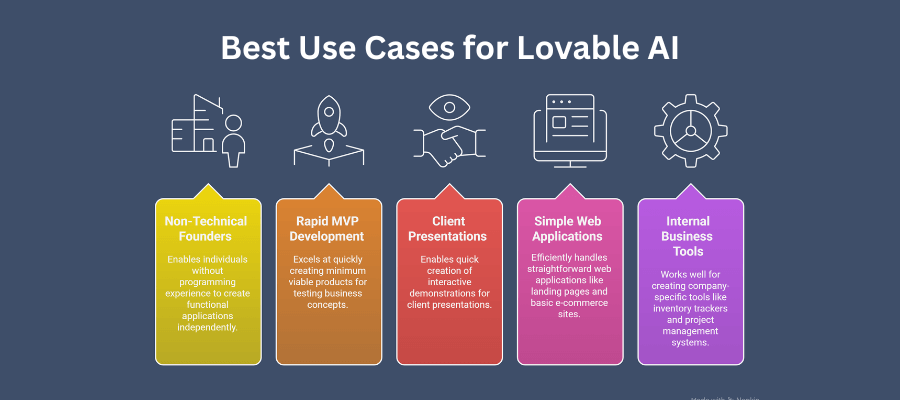
Non-Technical Founders and Entrepreneurs: Lovable enables individuals without programming experience to create functional applications independently. Founders can transform business ideas into working prototypes without hiring developers or learning to code. This self-sufficiency accelerates the early stages of startup development and validation.
Rapid MVP Development: The platform excels at quickly creating minimum viable products for testing business concepts. Users can generate functional applications in hours rather than weeks, allowing for faster market testing and iteration. This rapid development cycle helps startups validate assumptions before significant investment.
Client Presentations and Demonstrations: Lovable enables quick creation of interactive demonstrations for client presentations. Consultants and agencies can transform concepts into clickable prototypes during or immediately after initial meetings. This capability improves client communication and shortens approval cycles.
Simple Web Applications: The platform efficiently handles straightforward web applications like landing pages, content management systems, and basic e-commerce sites. These applications benefit from Lovable’s standardized components and templates without requiring extensive customization.
Internal Business Tools: Lovable works well for creating company-specific tools like inventory trackers, customer databases, and project management systems. These internal applications often have straightforward requirements that align with Lovable’s capabilities while delivering significant operational value.
Which is Right for You?
| User Profile | Recommended Platform | Rationale |
| Software Developers | Replit | Provides complete coding flexibility, language choice, and professional development tools while enhancing productivity with AI assistance. |
| Non-Technical Founders | Lovable AI | Enables application creation without coding knowledge, allowing founders to build and test ideas independently. |
| Technical Startups | Replit | Offers the customization depth needed for unique product development while supporting team collaboration. |
| Non-Technical Startups | Lovable AI | Provides faster time-to-market for testing business concepts without technical hiring requirements. |
| Students Learning to Code | Replit | Creates a supportive environment for learning programming fundamentals with real coding practice. |
| Product Managers | Lovable AI | Allows quick prototype creation for stakeholder feedback without development team dependencies. |
| Enterprise Development Teams | Replit | Supports complex applications with custom requirements, integration needs, and security considerations. |
| Small Business Owners | Lovable AI | Enables creation of business applications without technical expertise or significant investment. |
When making your selection, consider these additional factors:
- Technical Expertise: Assess your team’s programming knowledge realistically. Replit requires coding skills, while Lovable minimizes this requirement.
- Project Complexity: Evaluate whether your application needs custom functionality beyond standard components. Complex requirements typically favor Replit’s flexibility.
- Development Timeline: Consider your time constraints. Lovable offers faster initial development, while Replit provides more sustainable long-term development.
- Budget Considerations: Analyze both immediate costs and long-term expenses including potential developer hiring needs for each option.
- Growth Projections: Consider how your application might evolve. Replit offers more scalability for complex growth, while Lovable excels at rapid iteration of simpler applications.
Note: Many organizations successfully use both platforms for different purposes – Lovable for rapid prototyping and Replit for production development.
Conclusion
The comparison between Replit AI vs Lovable AI reveals two powerful but fundamentally different approaches to modern software development. Replit maintains coding at its core while enhancing developer productivity through collaboration features and AI assistance.
Both platforms successfully address the growing demand for accelerated software development through different strategies. Replit enhances traditional development with AI assistance, while Lovable reimagines the development process entirely through AI generation. Neither approach is universally superior – each excels in specific contexts depending on user requirements, technical capabilities, and project goals.
As AI continues transforming software development, both platforms will likely evolve toward greater capability and accessibility. The distinction between code-first and natural language development approaches may gradually blur as AI assistants become more sophisticated. For now, understanding the strengths and limitations of Replit AI vs Lovable AI enables informed platform selection aligned with your specific development needs.
Frequently Asked Questions
Can I export code from Lovable AI to continue development elsewhere?
Lovable AI provides limited code export functionality. Users can access generated frontend React components and basic backend code, but the exported code lacks the integrated structure of the hosted application. For complete portability, Replit offers superior code ownership and export options through Git integration and direct downloads.
Does Replit require constant internet connectivity?
Yes, Replit operates entirely in the cloud and requires an active internet connection for development. The platform does not currently offer offline development capabilities. Some limited code editing is possible through the mobile app, but full functionality requires web access through a desktop or mobile browser.
Which platform offers better database integration options?
Replit provides more comprehensive database options, supporting MongoDB, PostgreSQL, MySQL, and SQLite with direct configuration access. Lovable AI includes built-in database functionality but limits configuration options to its visual interface. Complex data relationships and custom queries are better supported in Replit’s developer-centric environment.
Can Lovable AI applications handle high user traffic?
Lovable AI applications can support moderate traffic levels on standard plans. The platform automatically scales to handle increased usage, but complex applications with high computational requirements may experience performance limitations. Enterprise plans offer enhanced performance guarantees for business-critical applications with higher traffic demands.
How do the AI capabilities compare between the two platforms?
Replit’s AI (Ghostwriter) functions as an intelligent coding assistant that suggests completions, explains code, and helps with debugging. Lovable’s AI serves as the primary creation engine, generating entire applications from text descriptions. Replit’s AI enhances developer productivity, while Lovable’s AI replaces traditional coding entirely for supported application types.
Shaif Azad
Related Post
Top 10 AI Development Companies in New Jersey for Business
Are you searching for the perfect AI development partner in New Jersey? Have you wondered which...
Top 10 AI Development Companies in New Hampshire
Are you watching New Hampshire’s tech landscape transform before your eyes? Your state is quietly becoming...
Top AI Companies in Nebraska Every Business Should Know
Are you a Nebraska business owner wondering how artificial intelligence could transform your operations? Picture this...


